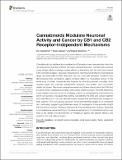Cannabinoids Modulate Neuronal Activity and Cancer by CB1 and CB2 Receptor-Independent Mechanisms
Author
Soderstrom, Ken; Soliman, Eman; Van Dross, Rukiyah
Abstract
Cannabinoids include the active constituents of Cannabis or are molecules that mimic the structure and/or function of these Cannabis-derived molecules. Cannabinoids produce many of their cellular and organ system effects by interacting with the well-characterized CB1 and CB2 receptors. However, it has become clear that not all effects of cannabinoid drugs are attributable to their interaction with CB1 and CB2 receptors. Evidence now demonstrates that cannabinoid agents produce effects by modulating activity of the entire array of cellular macromolecules targeted by other drug classes, including: other receptor types; ion channels; transporters; enzymes, and protein- and non-protein cellular structures. This review summarizes evidence for these interactions in the CNS and in cancer, and is organized according to the cellular targets involved. The CNS represents a well-studied area and cancer is emerging in terms of understanding mechanisms by which cannabinoids modulate their activity. Considering the CNS and cancer together allow identification of non-cannabinoid receptor targets that are shared and divergent in both systems. This comparative approach allows the identified targets to be compared and contrasted, suggesting potential new areas of investigation. It also provides insight into the diverse sources of efficacy employed by this interesting class of drugs. Obtaining a comprehensive understanding of the diverse mechanisms of cannabinoid action may lead to the design and development of therapeutic agents with greater efficacy and specificity for their cellular targets.
Date
2017-10-10
Citation:
APA:
Soderstrom, Ken, & Soliman, Eman, & Van Dross, Rukiyah. (October 2017).
Cannabinoids Modulate Neuronal Activity and Cancer by CB1 and CB2 Receptor-Independent Mechanisms.
,
(),
-
. Retrieved from
http://hdl.handle.net/10342/8039
MLA:
Soderstrom, Ken, and Soliman, Eman, and Van Dross, Rukiyah.
"Cannabinoids Modulate Neuronal Activity and Cancer by CB1 and CB2 Receptor-Independent Mechanisms". .
. (),
October 2017.
June 29, 2024.
http://hdl.handle.net/10342/8039.
Chicago:
Soderstrom, Ken and Soliman, Eman and Van Dross, Rukiyah,
"Cannabinoids Modulate Neuronal Activity and Cancer by CB1 and CB2 Receptor-Independent Mechanisms," , no.
(October 2017),
http://hdl.handle.net/10342/8039 (accessed
June 29, 2024).
AMA:
Soderstrom, Ken, Soliman, Eman, Van Dross, Rukiyah.
Cannabinoids Modulate Neuronal Activity and Cancer by CB1 and CB2 Receptor-Independent Mechanisms. .
October 2017;
():
.
http://hdl.handle.net/10342/8039. Accessed
June 29, 2024.
Collections

